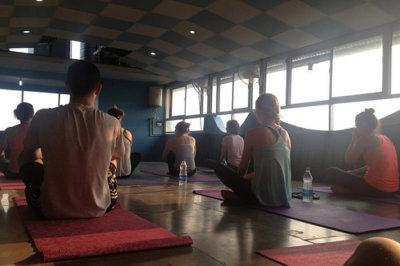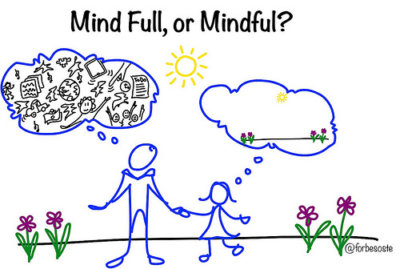5 Ways to Make Mindfulness Easier
Mindfulness can seem so exciting when we first begin practising it. But then, like any new learning, the roadblocks start. We get bored, or life gets so challenging we aren’t so sure we want to stay in the present moment after all. Mindfulness can start to feel like hard work, and we can question if we can be bothered.
Given the proven benefits of mindfulness to improve moods and increase clarity of mind, it’s worth trying to stick to it. Try these tips to not only make mindfulness an easier part of your life, but to keep yourself consistent.
5 Ways to Make Being Mindful Easier
1. Give up the comparison.
If others around you seem to have an easier time being mindful than you, it can be hard to not either judge yourself as not good enough, or decide you are not ‘doing it right’. But there is no perfect way to do mindfulness. There are by now many teachers and many ways into being mindful – breath work, body scanning, meditation, and yoga are just some paths. You have to work with what gives you results and brings you peace and clarity, not what other people say works for them.
Remember, too, that mindfulness is subjective. It’s a personal experience we cannot ‘show’ to someone else. One person’s mindfulness is someone else’s state of distraction! Your only measurement of mindfulness is with what you personally have experienced.

By: Jair Cabal
The other thing that can happen if you fall into comparison over mindfulness is that you might get competitive. But there is no destination with mindfulness, so how can you win? The only place you have to be is right here, where you are.
If you do encounter a feeling of competitiveness, why not use it as a moment to be mindful? Don’t judge yourself for feeling competitive. Instead, try being fully present to the feelings of jealously and inadequacy we all must face now and then. What can they teach you?
2. Keep track of your results.
If you are that competitive sort, and the feeling of ‘no end in sight’ that mindfulness can bring has you feeling defeated, why not try keeping a ‘mindfulness record’?
For some people this can mean keeping track of your mindfulness milestones, for example, charting the days you spend time being mindful and for how long. While some people might say this is not in the spirit of ‘no attachment’ that mindfulness is about, if it helps you keep going, why worry what others think? Work with what inspires you. Again, mindfulness is your personal experience.
 If feeling good is your main incentive, you can instead keep a record of wonderful mindful moments. This might be in the form of an ongoing list of all the things mindfulness has helped you recognise – a rose blooming on the neighbour’s rosebush, a moment watching your child sleep, that a stranger smiled at you on the tube.
If feeling good is your main incentive, you can instead keep a record of wonderful mindful moments. This might be in the form of an ongoing list of all the things mindfulness has helped you recognise – a rose blooming on the neighbour’s rosebush, a moment watching your child sleep, that a stranger smiled at you on the tube.
3. Make mindfulness a no-brainer.
We all know that mindfulness works best as part of our daily routine. Yet no matter how committed we are to our mindfulness meditation practise, or how many times we tell ourselves we’ll spend five minutes daily when we get to work doing some deep breathing and centring, things can and do go wrong. There is some sort of crisis at the office, or we go on vacation and our meditation time goes out the window despite best intentions.
Attaching one of your daily mindfulness moments to an essential activity doesn’t mean that you stop your half an hour meditating or your evening time in the garden being present. It simply means that no matter what happens, if everything else goes out the window you’ve at least had five minutes of being fully in the now. This might involve making your morning tooth brushing a time to stop worrying about your day ahead and only notice the sensation of tooth brushing in all its foamy glory. Or five minutes added to your breakfast schedule to eat with total mindful focus, or walking the dog mindfully.
If you’ve heard this idea before and not tried it because you are convinced you are not the sort to ever skip your meditation or other mindfulness commitment, remember that another five minutes at some other point of the day couldn’t hurt, and it could mean that in the future if life changes you stay on track. So why not do both?
4. Add words to your mindfulness.

By: Emma Larkins
Wait… add words?! Isn’t the whole point of mindfulness to clear our minds of unnecessary thoughts? Well, yes.
But as we all know, the second we decide to get mindful is the second every silly niggly worry of the week rushes in and does a tap dance across our brain.
A way to lessen this onslaught of thought is to combine mindfulness with journalling. Having a ‘brain dump’ on paper before doing your mindfulness practise can leave you to a much deeper sense of presence. Many of our minds let go more when we get things on paper than if we just ‘think’ through something. Try setting a timer for five minutes and writing down any thought that comes up. Ripping the paper up after can increase the feeling of ‘letting go’ of the worries that arise.
This method of journalling as a ‘brain dump’ is also a great technique to use by itself throughout the day when you are having troubles being mindful, and it’s very practical. You might not be able to close your eyes and breathe deeply in front of your colleagues, but they won’t know the difference if you are scrawling out worries on a piece of paper. Only you’ll know the difference when your clarity of mind kicks back in.
5. Get support on your journey.

By: Nazareth College
Mindfulness is far easier in likeminded company. If you surround yourself with people constantly moaning about the past, or anxious about the future, it will trigger your own worries. Of course we all need to learn from the past and plan for our future, but having at least a few friends who support your decision to appreciate the now moment (and don’t try to compete with you, see point one!) can be a great encouragement to keep mindful.
If none of your friends are yet into mindfulness, consider trying a local group or class. With mindfulness now an exploding trend worldwide, there should be something available. Other activities that integrate mindfulness that might interest you if there is no mindfulness group per se include yoga, tai chi, and meditation, all now recommended by the NHS as useful interventions for emotional wellbeing.
If you are considering therapy, you might also want to try working with a therapist who integrates mindfulness into their offerings. Mindfulness-based cognitive therapy (MBCT) is one strain to consider, although therapists of all schools of training now also integrate the technique into their practise. You can always ask nearby psychotherapy offices if any counsellors or therapists are available who use mindfulness with clients.
Do you have another tip for staying mindful? Or would you like to share a story about your own personal struggles with mindfulness? Comment below, we love hearing from you.





